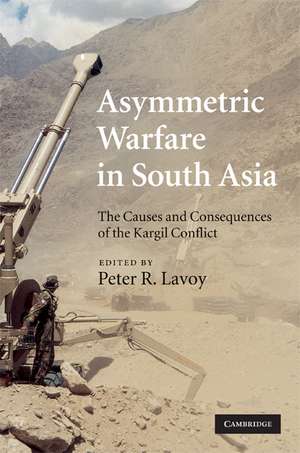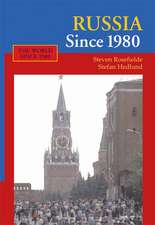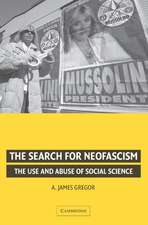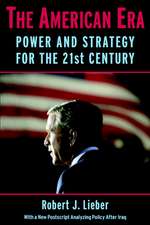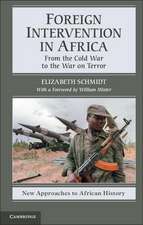Asymmetric Warfare in South Asia: The Causes and Consequences of the Kargil Conflict
Editat de Peter R. Lavoyen Limba Engleză Hardback – 11 noi 2009
Preț: 796.93 lei
Preț vechi: 926.67 lei
-14% Nou
Puncte Express: 1195
Preț estimativ în valută:
152.51€ • 158.64$ • 125.91£
152.51€ • 158.64$ • 125.91£
Carte tipărită la comandă
Livrare economică 14-28 aprilie
Preluare comenzi: 021 569.72.76
Specificații
ISBN-13: 9780521767217
ISBN-10: 0521767210
Pagini: 426
Ilustrații: 6 maps 6 tables
Dimensiuni: 160 x 234 x 25 mm
Greutate: 0.73 kg
Editura: Cambridge University Press
Colecția Cambridge University Press
Locul publicării:Cambridge, United Kingdom
ISBN-10: 0521767210
Pagini: 426
Ilustrații: 6 maps 6 tables
Dimensiuni: 160 x 234 x 25 mm
Greutate: 0.73 kg
Editura: Cambridge University Press
Colecția Cambridge University Press
Locul publicării:Cambridge, United Kingdom
Cuprins
1. Introduction: the importance of the Kargil conflict Peter R. Lavoy; Part I. Causes and Conduct of the Conflict: 2. The strategic context of the Kargil conflict: a Pakistani perspective Zafar Iqbal Cheema; 3. Pakistan's motivations and calculations for the Kargil conflict Feroz Hassan Khan, Peter R. Lavoy and Christopher Clary; 4. Military operations in the Kargil conflict John H. Gill; 5. American diplomacy and the 1999 Kargil Summit at Blair House Bruce Riedel; 6. Kargil: the nuclear dimension Timothy D. Hoyt; 7. Why Kargil did not produce general war: the crisis-management strategies of Pakistan, India, and the United States Peter R. Lavoy; Part II: Consequences and Impact of the Conflict: 8. Surprise at the top of the world: India's systemic and intelligence failure James J. Wirtz and Surinder Rana; 9. Militants in the Kargil conflict: myths, realities, and impacts C. Christine Fair; 10. The impact of the Kargil conflict and Kashmir on Indian politics and society Praveen Swami; 11. The Kargil conflict's impact on Pakistani politics and society Saeed Shafqat; Part III. Lessons Learned: 12. The lessons of Kargil as learned by India Rajesh M. Basrur; 13. The lessons of Kargil as learned by Pakistan Hasan-Askari Rizvi; 14. The Kargil crisis: lessons learned by the United States Rodney W. Jones and Joseph McMillan; 15. Kargil, deterrence, and international relations theory Robert Jervis.
Recenzii
'Unlike most discussions of conflict between the nuclear-armed nations of South Asia, this combines contributions from experts in both of those countries, as well as American perspectives. It is especially comprehensive and balanced and blends theory and policy analysis in the best way.' Richard K. Betts, Director, Saltzman Institute of War and Peace Studies, Columbia University
'The 1999 Kargil War was a rare and dangerous moment in history when two nuclear powers and two democracies went to war despite the risks of nuclear escalation. This excellent book explains, in more detail and depth than ever before, the crucial decisions made in Islamabad, New Delhi, and in the mountain peaks of Kashmir that led to the Kargil conflict and led to its eventual resolution.' Scott D. Sagan, Professor of Political Science and Co-Director of the Center for International Security and Cooperation (CISAC), Stanford University
'The ugly stability in South Asia, unfortunately, will continue to be periodically disrupted by different kinds of limited wars. Peter Lavoy's Asymmetric Warfare in South Asia deserves wide reading because it is a meticulous examination of the first, but perhaps not the last, limited war to occur in the Indian subcontinent under the shadow of nuclear weaponry. Both academics and policymakers alike will be informed - and sobered - by this excellent work.' Ashley J. Tellis, Senior Associate, Carnegie Endowment for International Peace
'This volume is required reading for anyone who wishes to understand Pakistan's military decision-making or the half-war in Kargil in 1999, just a year after India and Pakistan tested nuclear weapons. Peter Lavoy, long a scholar of South Asian military affairs, assembled a first-rate team from Pakistan, India and the United States to examine the causes, conduct and impact of the Kargil conflict, based in part on an astonishing number of interviews with high-level participants from both sides. … a book that combines many important insights and a welcome readability.' Survival
'… the book has much depth, and will be useful for students, academics and policy-makers interested in South Asian issues … Asymmetric Warfare in South Asia is a comprehensive independent research study that offers rigorous analysis of primary source interviews.' Punam Pandey, Contemporary South Asia
'The 1999 Kargil War was a rare and dangerous moment in history when two nuclear powers and two democracies went to war despite the risks of nuclear escalation. This excellent book explains, in more detail and depth than ever before, the crucial decisions made in Islamabad, New Delhi, and in the mountain peaks of Kashmir that led to the Kargil conflict and led to its eventual resolution.' Scott D. Sagan, Professor of Political Science and Co-Director of the Center for International Security and Cooperation (CISAC), Stanford University
'The ugly stability in South Asia, unfortunately, will continue to be periodically disrupted by different kinds of limited wars. Peter Lavoy's Asymmetric Warfare in South Asia deserves wide reading because it is a meticulous examination of the first, but perhaps not the last, limited war to occur in the Indian subcontinent under the shadow of nuclear weaponry. Both academics and policymakers alike will be informed - and sobered - by this excellent work.' Ashley J. Tellis, Senior Associate, Carnegie Endowment for International Peace
'This volume is required reading for anyone who wishes to understand Pakistan's military decision-making or the half-war in Kargil in 1999, just a year after India and Pakistan tested nuclear weapons. Peter Lavoy, long a scholar of South Asian military affairs, assembled a first-rate team from Pakistan, India and the United States to examine the causes, conduct and impact of the Kargil conflict, based in part on an astonishing number of interviews with high-level participants from both sides. … a book that combines many important insights and a welcome readability.' Survival
'… the book has much depth, and will be useful for students, academics and policy-makers interested in South Asian issues … Asymmetric Warfare in South Asia is a comprehensive independent research study that offers rigorous analysis of primary source interviews.' Punam Pandey, Contemporary South Asia
Descriere
A unique account of military conflict under the shadow of nuclear escalation, with access to the soldiers and politicians involved.
